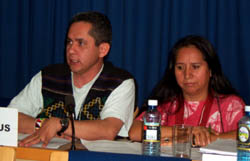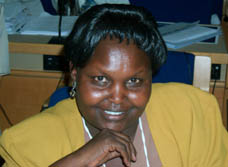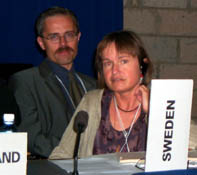 |
 The
International Indigenous Forum on Biodiversity coordinated inputs,
emphasizing their membership's support for this network's continued
mandate to work directly and closely with CBD participations on
Article 8j and the convention as a whole. The
International Indigenous Forum on Biodiversity coordinated inputs,
emphasizing their membership's support for this network's continued
mandate to work directly and closely with CBD participations on
Article 8j and the convention as a whole.
Chair Elaine
Fisher [left] and participants listened to specific recommendations
on follow-up actions regarding the Article 8(j) work programme
made indigenous peoples organizations, including El Conséjo de
Todas Las Tierras de Mapuche, Chile; Coordination Mapuche de Newquen,
Argentina; The Russian Association of Indigenous Peoples of the
North (RAIPON); Coordinadora
de las Organizaciones Indigenas de la Cuenca Amazonica (COICA);
Kawatea Chambers of New Zealand; Colombian Indigenous Movement;
Indigenous Development and Information Network; the Canadian Indigenous
Caucus; and the Indigenous Women's Biodiversity Network.
  Fred Fortier, Canadian Indigenous Caucus [photo on the
right, left-hand side], said that Article 15 on access and
benefit sharing was entirely related to Article 8(j) and said
the mandate of the ad hoc working group on traditional knowledge
was never limited to the latter article. He added that the CBD's
text's notion of "approval" is not as good as the notion of prior
informed consent.
Fred Fortier, Canadian Indigenous Caucus [photo on the
right, left-hand side], said that Article 15 on access and
benefit sharing was entirely related to Article 8(j) and said
the mandate of the ad hoc working group on traditional knowledge
was never limited to the latter article. He added that the CBD's
text's notion of "approval" is not as good as the notion of prior
informed consent.
A representative
of Indigenous Development and Information Network (on the right)
emphasized the need for full and direct participation of indigenous
women and communities in all levels of CBD policy formulation
and implementation, further stressing their rights to slow biodiversity
prospecting.
 Jorge
Nawel of the Mapuche de Newquen, Argentina [photo on the left,
left-hand side], suggested incorporation of the muwalpo concept
into the CBD. This concept emphasizes the integration of cultural
and biodiversity paradigms, incorporating land and territorial
rights, philosophies and ways of life, political and economic
decisions, cultural and social relations between people and biodiversity.
José Jorge
Nawel of the Mapuche de Newquen, Argentina [photo on the left,
left-hand side], suggested incorporation of the muwalpo concept
into the CBD. This concept emphasizes the integration of cultural
and biodiversity paradigms, incorporating land and territorial
rights, philosophies and ways of life, political and economic
decisions, cultural and social relations between people and biodiversity.
José  Nain
of Conséjo de Todas Las Tierras de Mapuche, Chile [photo on
the left, right-hand side], highlighted the uniquely collective
dimensions of indigenous knowledge. Nain
of Conséjo de Todas Las Tierras de Mapuche, Chile [photo on
the left, right-hand side], highlighted the uniquely collective
dimensions of indigenous knowledge.
Michael Todishev,
Vice-President of the Russian Association of Indigenous Peoples
of the North [mtodishev@mail.ru,
on the right] said that the 13 indigenous groups of Russia
need assistance in protecting and reversing the loss of their
language, cultures and traditions which are crucial for biodiversity
conservation and sustainable use.
 RealAudio of Mr. Nawel, Nain
RealAudio of Mr. Nawel, Nain
and Todishev's presentations (excerpts)
 Maui
Solomon, Kawatea Chambers of New Zealand [mauisolomon@hotmail.com,
left], urged for support of sui generis systems to protect
indigenous knowledge with respect to biodiversity, stressing that
his people's notion of biodiversity property center on the obligations
of respect of inherent life forces as a prerequisite for the sustainable
use of biodiversity as opposed to the economic exploitation of
genetic resources inherent in most Western notions of intellectual
property. In recognition of the fact that most of the earth's
biodiversity has been maintained by indigenous peoples and their
cultures despite the ravages of colonization, he urged COP-5 delegates
to assure the direct input of indigenous peoples without filtered
mechanisms. Maui
Solomon, Kawatea Chambers of New Zealand [mauisolomon@hotmail.com,
left], urged for support of sui generis systems to protect
indigenous knowledge with respect to biodiversity, stressing that
his people's notion of biodiversity property center on the obligations
of respect of inherent life forces as a prerequisite for the sustainable
use of biodiversity as opposed to the economic exploitation of
genetic resources inherent in most Western notions of intellectual
property. In recognition of the fact that most of the earth's
biodiversity has been maintained by indigenous peoples and their
cultures despite the ravages of colonization, he urged COP-5 delegates
to assure the direct input of indigenous peoples without filtered
mechanisms.
 Antonio
Jacanamijoy, Coordinadora de las Organizaciones Indigènas de la
Cuenca Amazónica [coica@uio.satnet.net
or coicacol@col1.telecom.com.co],
linkages between indigenous knowledge and indigenous territories
and lands. He emphasized the importance of recognizing indigenous
control, mutually agreed terms of prior informed consent and the
need to directly involve indigenous technical experts. Antonio
Jacanamijoy, Coordinadora de las Organizaciones Indigènas de la
Cuenca Amazónica [coica@uio.satnet.net
or coicacol@col1.telecom.com.co],
linkages between indigenous knowledge and indigenous territories
and lands. He emphasized the importance of recognizing indigenous
control, mutually agreed terms of prior informed consent and the
need to directly involve indigenous technical experts.
A Colombian
Indigenous Movement representative [right] insisted on
the full protection of the traditional knowledge of Indigenous
Peoples, including the cultural identities and integrity which
make such knowledge sustainable.
 RealAudio excerpts of Mr. Slomon, Jacanamijoy
RealAudio excerpts of Mr. Slomon, Jacanamijoy
and Colombian Indigenous Movement representative's presentations
 Rodah
C. Retino, African Indigenous Women's Organization, spoke on behalf
of the Indigenous Women's Biodiversity Network. She noted that
the marginalization of indigenous and local women in CBD and other
related processes does not negate the fact that these women are
a major source of traditional knowledge crucial to biodiversity's
sustainable use and conservation. She also called for the creation
of a separate work programme element under Article 8(j) to address
the concerns of women of indigenous and local communities. Rodah
C. Retino, African Indigenous Women's Organization, spoke on behalf
of the Indigenous Women's Biodiversity Network. She noted that
the marginalization of indigenous and local women in CBD and other
related processes does not negate the fact that these women are
a major source of traditional knowledge crucial to biodiversity's
sustainable use and conservation. She also called for the creation
of a separate work programme element under Article 8(j) to address
the concerns of women of indigenous and local communities.
 Real Audio of Mrs. Retino's presentation
Real Audio of Mrs. Retino's presentation
|
 SWITZERLAND proposed developing coherent guidelines and priority
setting for implementing Article 8(j) in relation to all CBD objectives
and vis-a-vis regulatory regimes other than the CBD.
SWITZERLAND proposed developing coherent guidelines and priority
setting for implementing Article 8(j) in relation to all CBD objectives
and vis-a-vis regulatory regimes other than the CBD.
|
 NAMIBIA echoed a G-77/CHINA reference to CBD Article 16.5, stressing
the promotion of appropriate forms of intellectual property protection
and stated that sui generis laws are applicable.
NAMIBIA echoed a G-77/CHINA reference to CBD Article 16.5, stressing
the promotion of appropriate forms of intellectual property protection
and stated that sui generis laws are applicable.
|
 NORWAY requested a reference to indigenous people as social,
cultural and political entities in line with ILO Convention #169
and suggested strengthening relations with the future UNFF
NORWAY requested a reference to indigenous people as social,
cultural and political entities in line with ILO Convention #169
and suggested strengthening relations with the future UNFF
|
|
|
|
 CANADA called for clarification of how the guidelines should
be developed, and prioritization of the work programme's tasks.
CANADA called for clarification of how the guidelines should
be developed, and prioritization of the work programme's tasks.
|
|
|
Side event: The Global
Invasive Species Programme: A Global and African Perspective
|
|
The
Global Invasive
Species Programme (GISP) held a workshop on GISP Phase II and
options for international arrangements under the CBD for tackling
the global problem of invasives. The GISP contributed in the drafting
of the CBD's Interim Guiding Principles on Invasive Species. Feedback
on GISP II is welcome and will be synthesized during a meeting Interim
GISP Sterring Committee to be held in Capetown, South Africa in
September 2000. Contact [j.waage@cabi.org]
 Workshop
facilitator, Jeff Waage, Chief Executive of the Center for Applied
Biosciences International (CABI)
[j.waage@cabi.org, shown
here on the left], said GISP-II aims to disseminate quality
information and best practices to promote awareness-raising and
capacity-building, information-sharing, strategy preparation and
action plans to research, monitor and control invasives. Potential
GISP research topics aimed at stimulating new ideas include: methods
to define the origin and pathways of invasive populations; environmentally-friendly
methods for the control and economic analysis of alien invasive
species; and restoration ecology. He suggested that a Global Biosecurity
Platform inevitably needs to be fleshed out to deal with he inevitable
links between invasive species, GMOs, food and biosafety, trade
and biodiversity conservation and sustainable use. Workshop
facilitator, Jeff Waage, Chief Executive of the Center for Applied
Biosciences International (CABI)
[j.waage@cabi.org, shown
here on the left], said GISP-II aims to disseminate quality
information and best practices to promote awareness-raising and
capacity-building, information-sharing, strategy preparation and
action plans to research, monitor and control invasives. Potential
GISP research topics aimed at stimulating new ideas include: methods
to define the origin and pathways of invasive populations; environmentally-friendly
methods for the control and economic analysis of alien invasive
species; and restoration ecology. He suggested that a Global Biosecurity
Platform inevitably needs to be fleshed out to deal with he inevitable
links between invasive species, GMOs, food and biosafety, trade
and biodiversity conservation and sustainable use.
 P.
Balakrishna, Head of IUCN's Regional
Biodiversity Programme in Asia [pbala@sitnek.lk,
right], recommended that COP-5 endorse GISP and adopt SBSTTA-4/5
Recommendations IV/4 and V/4 on developing guiding principles for
the prevention of impacts of alien species and identifying priority
areas of work in isolated ecosystems. P.
Balakrishna, Head of IUCN's Regional
Biodiversity Programme in Asia [pbala@sitnek.lk,
right], recommended that COP-5 endorse GISP and adopt SBSTTA-4/5
Recommendations IV/4 and V/4 on developing guiding principles for
the prevention of impacts of alien species and identifying priority
areas of work in isolated ecosystems.
Rich
Blaustein, Environmental Lawyer with Defenders
of Wildlife [rblaustein@defenders.org],
called for COP-5 adoption of the interim guidelines on invasives.
He also recommended that COP-5 create an ad hoc working group
to develop an Alien Species Protocol to the CBD, to bolster Article
8(h) on preventing the introduction, control and eradication of
those species which threaten species, habitats and ecosystems.
 Greg
Sherley Programme Officer with the South Pacific Regional Environment
Programme (SPREP) [greg@sprep.org.ws,
left], described lessons learned in the SPREP regional invasive
species strategy. A technical review has synthesized information
on: Southern Pacific invasives; their taxonomy and biogeography;
their ecology; their cross-border and mostly intra-national, inter-island
pathways of travel; the probability of their spreading and threatening
wild biodiversity; and measures for their control and eradication.
He highlighted the confounding relationship between biosafety concerns
and invasive species and the importance of the Global Taxonomy Initiative. Greg
Sherley Programme Officer with the South Pacific Regional Environment
Programme (SPREP) [greg@sprep.org.ws,
left], described lessons learned in the SPREP regional invasive
species strategy. A technical review has synthesized information
on: Southern Pacific invasives; their taxonomy and biogeography;
their ecology; their cross-border and mostly intra-national, inter-island
pathways of travel; the probability of their spreading and threatening
wild biodiversity; and measures for their control and eradication.
He highlighted the confounding relationship between biosafety concerns
and invasive species and the importance of the Global Taxonomy Initiative.
Nattley
Williams, Legal Officer at the IUCN
Environmental Law Centre in Bonn [nwilliams@elc.iucn.org,
 right]
spoke on legal measures regarding invasive species. She said that
over 50 international instruments address issues related to invasive
species and called for national implementation based on the precautionary
rather than preventative principle. Among them are the Law of the
Sea, Wetlands Convention, the Convention on Migratory Species, International
Plant Protection Convention, and the Global Environmental Facility.
She emphasized the need to consider all options for controlling
invasives internationally, including: risk assessment rules; specific
CBD recommendations to and collaboration with the World Trade Organization;
permits and licensing; application of the polluter pays principles;
and codes of conduct on invasives. right]
spoke on legal measures regarding invasive species. She said that
over 50 international instruments address issues related to invasive
species and called for national implementation based on the precautionary
rather than preventative principle. Among them are the Law of the
Sea, Wetlands Convention, the Convention on Migratory Species, International
Plant Protection Convention, and the Global Environmental Facility.
She emphasized the need to consider all options for controlling
invasives internationally, including: risk assessment rules; specific
CBD recommendations to and collaboration with the World Trade Organization;
permits and licensing; application of the polluter pays principles;
and codes of conduct on invasives.
Gasper
Mallya, Operations Officer, Lake Victoria Environmental Management
Programme, gave an overview of initiatives for monitoring and controlling
water hyacinth invasions within Lake Victoria. Manual removal, mechanical
harvesting and biological control using beetles have thus far reduced
the 14,000 ha areal coverage of water hyacinth by nearly 60%.
Scott
E. Miller, International Centre of Insect Physiology and Ecology
(ICIPE) [miller.scott@nmnh.si.edu],
pointed to the substantive technical and political outcomes of a
Workshop on Invasive Species in Eastern Africa held 5-6 July 1999
on Invasives, whose proceedings are at [http://www.icipe.org/].
Ensuing
discussion touched on: whether or not a protocol on invasives under
the CBD was necessary; possibilities for developing GISP and/or
an Invasives Protocol through and with other international entities;
how the International Plant Protection Convention touches on pests
to flora; the relationship between WTO trade, risk and quarantine
rules and the CBD's precautionary principle and interim guidelines
for controlling invasives; the potential industrial or development
value of harvesting and using invasive species; and the lack of
standard legal and ecological definitions regarding exotic,
weed, alien, pest and invasive species.
|
|
|
Side event: The CBD, FAO
and WTO: Never the Three Shall Meet?
|
|
The Third
World Network held a panel discussion on the intersection of
the CBD, the FAO's International Undertaking on Plant Genetic Resources
(IU) and the WTO's Agreement on Trade-Related Aspects of Intellectual
Property (TRIPs). Panelists were asked to propose appropriate models
for equitable benefit-sharing, and debate whether patents can co-exist
with collective property rights.
 Doreen
Stabinsky (Council for Responsible Genetics, center), the panel's
moderator, noted that rights under TRIPs are accorded to individuals
who are generally the users of biodiversity or such resources. Under
the IU, the concept of farmers' rights includes community rights
and safeguards the holders or providers of biodiversity resources. Doreen
Stabinsky (Council for Responsible Genetics, center), the panel's
moderator, noted that rights under TRIPs are accorded to individuals
who are generally the users of biodiversity or such resources. Under
the IU, the concept of farmers' rights includes community rights
and safeguards the holders or providers of biodiversity resources.
 Tewolde
Egziabher (Environmental Protection Agency, Ethiopia, shown here
on the left) noted that the private rights accorded by TRIPs
do not adequately cover or apply to communal knowledge and innovations.
He stated that the relation between the CBD and TRIPs was a territorial
conflict, while noting that the concept of individual rights historically
has come after communal rights (as reflected in the process of enclosure
in Europe). As such Article 8(j) for indigenous and local communities
and the IU for farmers seeks to redress the imbalance to protect
collective rights and innovation. He noted that TRIPs interferes
in this endeavor in a number of ways. First, its focus on individual
rights leads to privatization and fragmentation as opposed to strengthening
community. The focus on the individual also inhibits the process
of innovation, which is also disrupted by concepts of benefit-sharing
which tend to put a price tag on knowledge and its use. Tewolde
Egziabher (Environmental Protection Agency, Ethiopia, shown here
on the left) noted that the private rights accorded by TRIPs
do not adequately cover or apply to communal knowledge and innovations.
He stated that the relation between the CBD and TRIPs was a territorial
conflict, while noting that the concept of individual rights historically
has come after communal rights (as reflected in the process of enclosure
in Europe). As such Article 8(j) for indigenous and local communities
and the IU for farmers seeks to redress the imbalance to protect
collective rights and innovation. He noted that TRIPs interferes
in this endeavor in a number of ways. First, its focus on individual
rights leads to privatization and fragmentation as opposed to strengthening
community. The focus on the individual also inhibits the process
of innovation, which is also disrupted by concepts of benefit-sharing
which tend to put a price tag on knowledge and its use.
 Jose
Esquinas, FAO Commission on Genetic
Resources for Food and Agriculture, AGD [bottom photo, middle],
started by outlining the importance of agrobiodiversity and the
IU for plant genetic resources, farmers' rights and food security.
He noted that there are two interlinked components to the value
of agrobiodiversity: 1) the agricultural biodiversity or raw material
itself; and 2) the instruments or technology used to manipulate
it. Combining the two generally results in a commercial product
which translates into financial profit. He presented a model outlining
the combination, noting that the technology side is generally the
domain of developed country and corporate interests and the agrobiodiversity
side the domain of farmers and communities. Unfortunately, to date
the technology side has generated and kept most of the profit, without
significant compensation to the holders of the raw material. The
present intellectual property system, including TRIPs, UPOV and
WIPO, general protects and provides incentives for the users of
technology, while the CBD and IU are an attempt to address the imbalance
by providing rights and incentives to the holders of plant genetic
resources. He noted the need for complementarity between the institutions
on both sides, allowing the harmonization of individual and collective
rights. Jose
Esquinas, FAO Commission on Genetic
Resources for Food and Agriculture, AGD [bottom photo, middle],
started by outlining the importance of agrobiodiversity and the
IU for plant genetic resources, farmers' rights and food security.
He noted that there are two interlinked components to the value
of agrobiodiversity: 1) the agricultural biodiversity or raw material
itself; and 2) the instruments or technology used to manipulate
it. Combining the two generally results in a commercial product
which translates into financial profit. He presented a model outlining
the combination, noting that the technology side is generally the
domain of developed country and corporate interests and the agrobiodiversity
side the domain of farmers and communities. Unfortunately, to date
the technology side has generated and kept most of the profit, without
significant compensation to the holders of the raw material. The
present intellectual property system, including TRIPs, UPOV and
WIPO, general protects and provides incentives for the users of
technology, while the CBD and IU are an attempt to address the imbalance
by providing rights and incentives to the holders of plant genetic
resources. He noted the need for complementarity between the institutions
on both sides, allowing the harmonization of individual and collective
rights.
Cecilia Oh
(Third World Network, top photo, second from the left) discussed
the IPR system contained in TRIPs. She noted that it was generally
created as an incentive system benefiting biotechnology and pharmaceutical
companies, which can profit from an individualistic and monopolistic
patent system. She noted the three general components of TRIPs Article
27.3(b) which is the core element of the WTO addressing plant genetic
resources. The provision
- allows countries to exclude plants and animals from patenting;
- requires patents for micro-organisms and micro-biological and
non-biological processes; and
- calls for protection for plant varieties.
She noted that there is no real concrete basis for discriminating
between plants, plant varieties and micro-biological processes,
except for a basic interest in profit. She noted that Article 27.3(b)
is up for review, although there has been disagreement over whether
it should address implementation or its substance. The Seattle WTO
Ministerial in November/December 1999 did not resolve this issue,
but saw a strong push by developing countries on the issue. She
concluded by noting work at the national and regional level including
legislation developed by the Organization for African Unity and
within the ASEAN group.
|
|
|
Side event: Global Biodiversity
Information Facility
|
|
 A
press briefing was held on the Global Biodiversity Information Facility
(GBIF) formally proposed by the OECD SubGroup on Biological Informatics,
[http://www.oecd.org/dsti/sti/s_t/ms/index.htm]
and endorsed by OECD science ministers in June 1999 per the request
of CBD COP-4. The GBIF will become operational in 2001 and aims
to allow people in all countries to share biological diversity information,
provide access to critical authority files and make the world's
scientific biodiversity data essentially freely available. For more
information: [http://www.gbif.org/]
or [http://www.gbif.net/]. A
press briefing was held on the Global Biodiversity Information Facility
(GBIF) formally proposed by the OECD SubGroup on Biological Informatics,
[http://www.oecd.org/dsti/sti/s_t/ms/index.htm]
and endorsed by OECD science ministers in June 1999 per the request
of CBD COP-4. The GBIF will become operational in 2001 and aims
to allow people in all countries to share biological diversity information,
provide access to critical authority files and make the world's
scientific biodiversity data essentially freely available. For more
information: [http://www.gbif.org/]
or [http://www.gbif.net/].
Ebbe
Nielsen, CSIRO Australia [ebbe.nielsen@ento.csiro.au,
left], gave an overview of the GBIF, a distributed network of
affiliated scientific biodiversity databases and a free-standing
organization closely tied to the CBD Clearing House Mechanism and
Diversitas. He noted the GBIF's initial focus is on species- and
specimen-level data with links to molecular, genetic and ecosystems
levels. The Facility will provide real-time information from multiple
sources, repatriate scientific data, correlate and synthesize data,
and make available automated data cleansing and verification. Any
country interested in developing the GBIF is invited to attend the
3rd Meeting of the Interim Steering Committee to be held 23-25 September
in Washington DC. For further information [jledward@nsf.org].
|
|
|
Side event: The Convention
on Migratory Species and the CBD
|
|
 Arnulf
Muller-Helmbrecht, Executive Secretary of The Convention on Migratory
Species (CMS) [ulfm-h@unep.de,
shown here on the left, with Nabiha Megateli of the ENB], shared
his thoughts regarding areas of comparative advantage within the
CMS framework that could strengthen the CBD's conservation and sustainable
use work on migratory species, their habitats and ecosystems. In
1996, the CMS and CBD Secretariats negotiated and signed a Memorandum
of Cooperation aimed at promoting an integrated, synergistic approach
to the implementation of these conventions cooperatively. Although
not yet further developed, a future joint work programme between
the CBD and CMS could be considered under operations of the convention
and will likely be up for more specific debate at COP-7 since Hamdallah
Zedan, CBD Executive Secretary has agreed to consult with the CMS
on a more sophisticated work programme. Arnulf
Muller-Helmbrecht, Executive Secretary of The Convention on Migratory
Species (CMS) [ulfm-h@unep.de,
shown here on the left, with Nabiha Megateli of the ENB], shared
his thoughts regarding areas of comparative advantage within the
CMS framework that could strengthen the CBD's conservation and sustainable
use work on migratory species, their habitats and ecosystems. In
1996, the CMS and CBD Secretariats negotiated and signed a Memorandum
of Cooperation aimed at promoting an integrated, synergistic approach
to the implementation of these conventions cooperatively. Although
not yet further developed, a future joint work programme between
the CBD and CMS could be considered under operations of the convention
and will likely be up for more specific debate at COP-7 since Hamdallah
Zedan, CBD Executive Secretary has agreed to consult with the CMS
on a more sophisticated work programme.
Such
a joint programme of work could rethink GEF criteria and take advantage
of the multiple-country research, monitoring, information-sharing
and conservation-oriented activities of CMS Secretariat, CMS Scientific
Council and its Parties and partners. Unlike the CBD, the CMS targets
specific migratory species and their transboundary habitats within
protected areas and on productive landscapes, often covering more
than one region or one transboundary wetland as in the case of Ramsar.
For example, current CMS initiatives target the white stork whose
total fly-way and range includes 78 countries, a African and Eurasian
programme on 170 migratory water birds, efforts to conserve whales
in the Mediterranean and Black Sea and Cetaceans (small whales)
in the Baltic North Seas.
For
general information on the CMS and opinions on priorities for CMS
and CBD collaboration, contact: [cms@unep.de]
or [http://www.wcmc.org.uk/cms/]
|
|
|
Parallel Event to the CBD:
Medicinal Plants, Traditional Medicines and Local Communities in
Africa
|
|
This Friday was the
last day of the 4-day International Conference on "Medicinal Plants,
Traditional Medicine and Local Communities in Africa: Challenges
and Opportunities of the New Millenium" held ICRAF. The conference
was convened by the Environmental Liaison Centre International (ELCI),
the Global Initiative for Traditional Systems (GIFTS) of Health
at the University of Oxford, UK and the Commonwealth Working Group
on Traditional and Complementary Health Systems. Conference objectives
were to: contribute to COP-5 outcomes relating to indigenous health
knowledge and the protection of traditional knowledge and intellectual
property rights; assess the status and disseminate information on
fragmented research initiatives in traditional medicine in Africa;
stimulate action and co-ordination in the supply, growth and sustainable
development of medicinal plant production in Africa. Over 25 papers
during 8 sessions were presented on three topical areas: the place
and traditional role of traditional health care systems and traditional
medicines in public health; intellectual property rights, development
of medicinal plant genetic resources and drug discovery; and the
sustainable use, trade and conservation of medicinal plants in Africa.
More than 75 participants from
Africa, Madagascar, Canada and Europe attended, including a number
of Central and East  African
traditional healers, traditional medicine manufacturers and indigenous
peoples' organizations. A report of the meeting is being prepared
by UNEP for presentation and distribution to COP-5. African
traditional healers, traditional medicine manufacturers and indigenous
peoples' organizations. A report of the meeting is being prepared
by UNEP for presentation and distribution to COP-5.
Indigenous Congolese,
Colette Mikila Embenako [right] and Stephan Ilundu BuLambo [middle]
of Project PIDP-KIVU, Democratic Republic of Congo talked with Dr.
J.K. Githae [left], Herbal Practitioner and Chairman of the School
of Alternative Medicine and Technology, Karati Rural Services Centre
in Kenya, about ways to formalize types of educational practices
within traditional African medicine and healing cultures.
 Katsuva
Kihala Dominique [photo on the right], displayed his traditional
herbal medicines that Laboratoire Metrabu makes and sells in the
Democratic Republic of Ghana. He stands here with traditional healers
Sekagyayahaya of the Uganda Seya Clinic and Nursing Home [seyaclinic@healthnet.ov.ug]
and Togbega Dabra VI a.k.a. Phanuel C. K. K. Aloka [alcom@africaonline.com.gh]. Katsuva
Kihala Dominique [photo on the right], displayed his traditional
herbal medicines that Laboratoire Metrabu makes and sells in the
Democratic Republic of Ghana. He stands here with traditional healers
Sekagyayahaya of the Uganda Seya Clinic and Nursing Home [seyaclinic@healthnet.ov.ug]
and Togbega Dabra VI a.k.a. Phanuel C. K. K. Aloka [alcom@africaonline.com.gh].
Togbega
Dabra VI, also a hereditary paramount Logba chief from Ghana, suggested
to them that traditional health systems in Africa be formalized
by law, through Traditional Practice Medicine Acts to recognize
and license traditional health practitioners and premises.
Cross-cutting
themes of the conference included spiritual and cultural aspects
of traditional medicine, gender, benefit-sharing and the sustainable
use of medicinal plants. Participants agreed to further contribute
to setting priorities for the Decade of Traditional Medicine. The
important role of traditional midwifery practices in Africa was
highlighted, and priority diseases identified as malaria and HIV/AIDS.
Participants also noted the lack of official recognition of traditional
health practitioners in many countries and the inadequacy of conservation
policies and action on the ground. Some participants suggested that
traditional healers be formally represented by Ministries of Health
rather than Ministries of Culture or Environment.
To
read or contribute to e-group discussions on the above topics, join
the Phytomedica list [phytomedica@egroups.com].
For proceedings of the conference, contact: Barbara Gimmell, [http://www.elciafrica.org/]
or [barbarag@elciafrica.org]
or Gemma Burford, HIV/AIDS Research Initiative on Traditional Healthcare
in Africa (HARITHAF) [harithaf@hotmail.com]
|
 IN
THE BREEZEWAYS IN
THE BREEZEWAYS
As COP-5 moves into its second week and delegates combat colds and
bellyaches, discussions in the breezeways naturally turned to invasive
species and a proposal for a Protocol. Participants supporting a
binding agreement noted the need to achieve parity in any trade
conflicts that could arise with the WTO. Delegates preferring the
guidelines stressed the need for measured progress at the policy
level and the most expeditious means to secure national implementation.
Right:
at the UN compound at Gigiri, buildings are not separated
by closed corridors, instead they are linked by open breezeways.
|
|
























